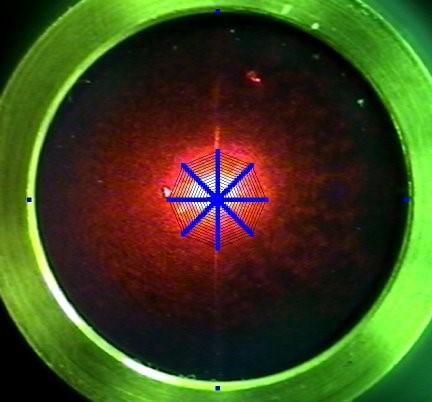Laser Doppler Vibrometer Calibration of Microphones

Microphone diaphragm vibration is measured with a laser Doppler vibrometer at 129 central points covering approximately 7 % of total diaphragm area.
Microphones are calibrated to determine their sensitivities for sound pressure measurements and to provide traceability for calibrations of other acoustical measurement equipment used in the lab or field, such as sound calibrators, sound level meters, and noise dosimeters. Primary microphone calibrations, which are carried out without the need for a reference to another standard of sound pressure (e.g., a calibrated microphone), are performed at national measurement institutes such as NIST and other organizations worldwide using the reciprocity method. This method was originally developed in the 1940s. The sensitivities of each of a set of three microphones are determined from the results of three independent measurements made with pairs of microphones connected by an acoustic coupler. Each pair consists of a transmitter and a receiver; the transmitter is driven electrically to produce sound in the coupler. The sensitivities of the microphones are determined from measurements of the electrical transfer impedance, which is the receiver output voltage divided by the transmitter current, and of the acoustic transfer impedance, which is determined from coupler cavity dimensions, environmental conditions, and gas properties. A reciprocity-based comparison method is also used at NIST to perform secondary calibrations of microphones; calibrated reference microphones serve as transmitters to calibrate test microphones acting as receivers.
Novel optical methods can provide alternatives to the long-established reciprocity calibration method for microphones and these methods show promise to provide advantages in calibration. To maintain world-class capabilities and advance the state-of-the art in acoustical calibrations, we are developing such an optical based microphone calibration method at NIST. We have built a testbed system to perform microphone calibrations using scanning laser interferometry that directly measures the diaphragm vibration of a microphone electrically driven as a transmitter in conjunction with drive current measurements. The system has already been used to investigate and optimize a spatial sampling method confined to a small central region of the diaphragm, and to develop a new precision microphone comparison calibration capability at selected frequencies that compares favorably to the NIST reciprocity-based comparison method. Further work is ongoing to investigate the system’s potential for performing primary calibrations. By avoiding repeat measurements in different couplers using multiple microphone pairs, the calibration of a single microphone may be accomplished more rapidly than with the reciprocity method.
Contacts
-
(301) 975-3898

